Economics Assignment: Price Elasticity of Demand and Trade Theories
VerifiedAdded on 2020/04/15
|7
|829
|324
Homework Assignment
AI Summary
This economics assignment delves into two key areas: price elasticity of demand and international trade theories. The first part examines how price elasticity influences firm decision-making, including production, pricing, and market strategies like price discrimination, providing a framework for understanding how businesses respond to market dynamics. The second part analyzes the theories of absolute and comparative advantage in international trade, highlighting their significance and practical applications. It explores how countries can benefit from specialization and trade based on their comparative advantages, while also addressing real-world exceptions and complexities in trade practices, using Japan as an example. The assignment provides a comprehensive overview of these economic concepts, offering insights into both microeconomic and macroeconomic principles.
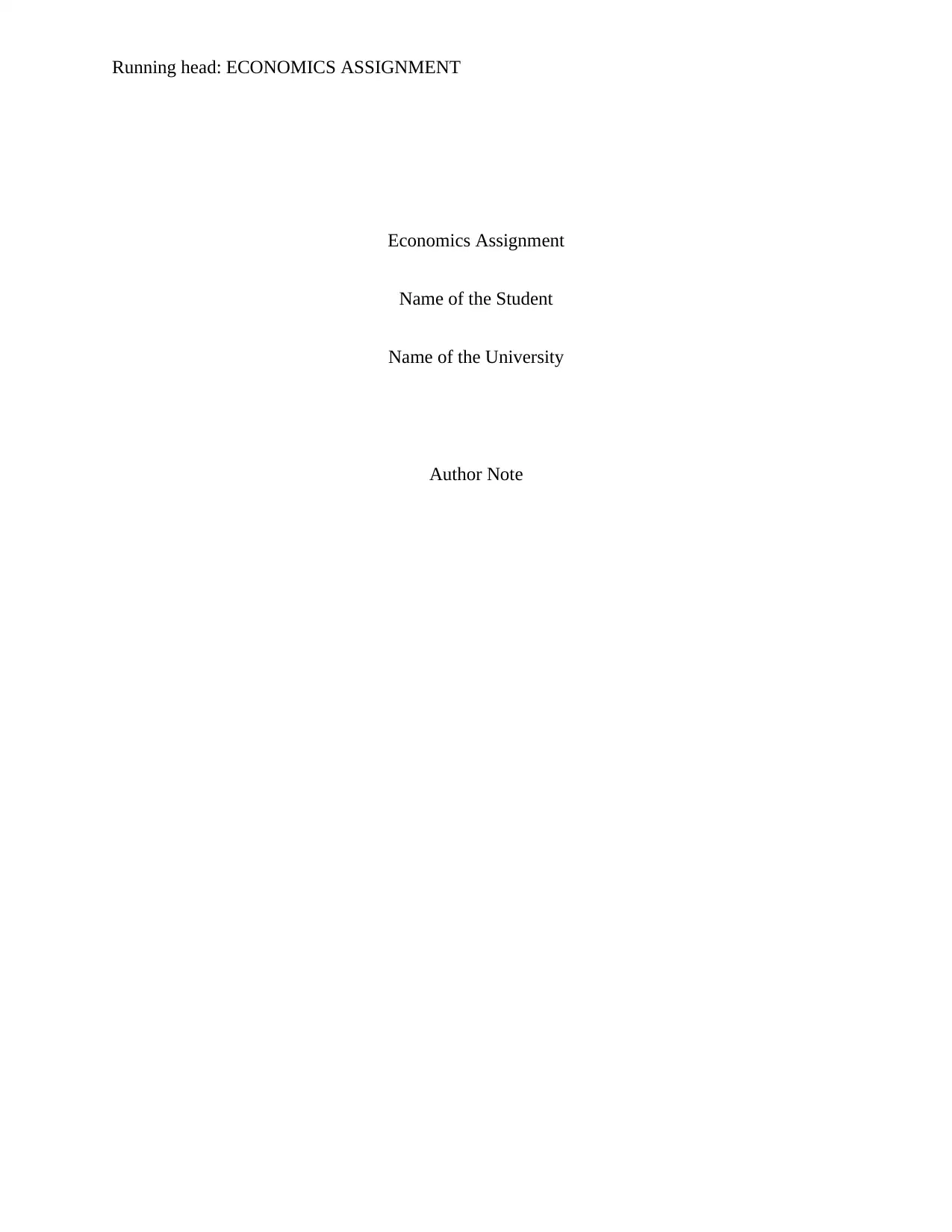
Running head: ECONOMICS ASSIGNMENT
Economics Assignment
Name of the Student
Name of the University
Author Note
Economics Assignment
Name of the Student
Name of the University
Author Note
Paraphrase This Document
Need a fresh take? Get an instant paraphrase of this document with our AI Paraphraser
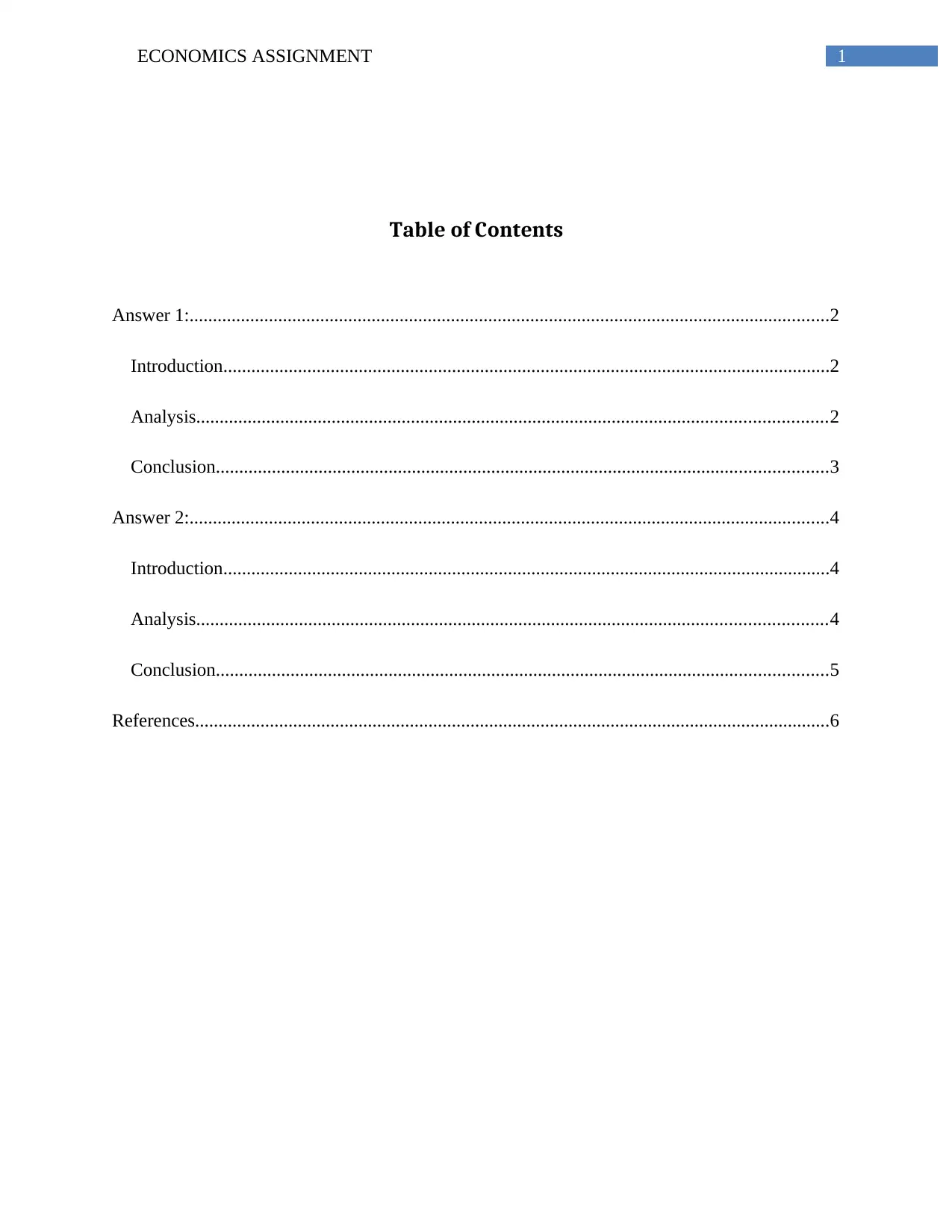
1ECONOMICS ASSIGNMENT
Table of Contents
Answer 1:.........................................................................................................................................2
Introduction..................................................................................................................................2
Analysis.......................................................................................................................................2
Conclusion...................................................................................................................................3
Answer 2:.........................................................................................................................................4
Introduction..................................................................................................................................4
Analysis.......................................................................................................................................4
Conclusion...................................................................................................................................5
References........................................................................................................................................6
Table of Contents
Answer 1:.........................................................................................................................................2
Introduction..................................................................................................................................2
Analysis.......................................................................................................................................2
Conclusion...................................................................................................................................3
Answer 2:.........................................................................................................................................4
Introduction..................................................................................................................................4
Analysis.......................................................................................................................................4
Conclusion...................................................................................................................................5
References........................................................................................................................................6
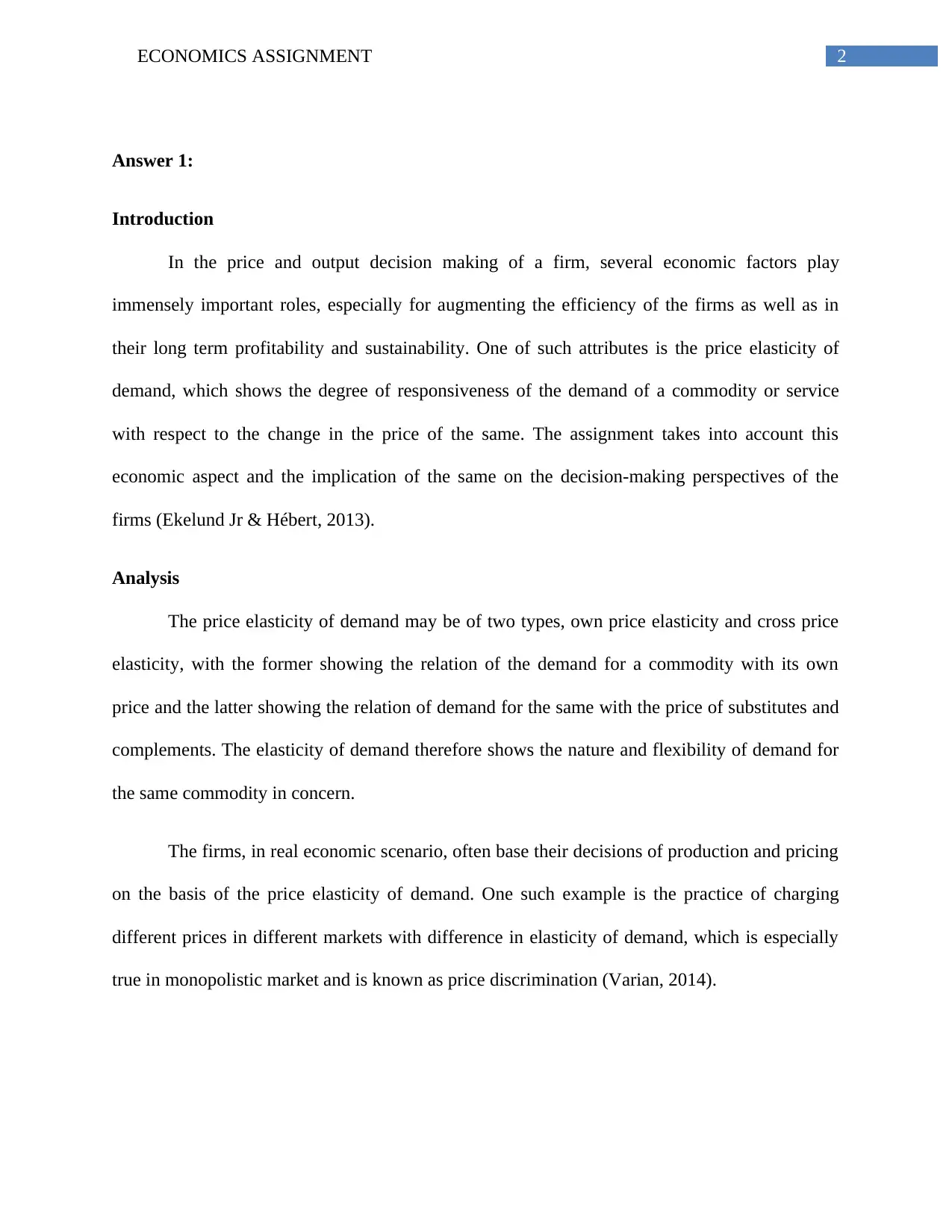
2ECONOMICS ASSIGNMENT
Answer 1:
Introduction
In the price and output decision making of a firm, several economic factors play
immensely important roles, especially for augmenting the efficiency of the firms as well as in
their long term profitability and sustainability. One of such attributes is the price elasticity of
demand, which shows the degree of responsiveness of the demand of a commodity or service
with respect to the change in the price of the same. The assignment takes into account this
economic aspect and the implication of the same on the decision-making perspectives of the
firms (Ekelund Jr & Hébert, 2013).
Analysis
The price elasticity of demand may be of two types, own price elasticity and cross price
elasticity, with the former showing the relation of the demand for a commodity with its own
price and the latter showing the relation of demand for the same with the price of substitutes and
complements. The elasticity of demand therefore shows the nature and flexibility of demand for
the same commodity in concern.
The firms, in real economic scenario, often base their decisions of production and pricing
on the basis of the price elasticity of demand. One such example is the practice of charging
different prices in different markets with difference in elasticity of demand, which is especially
true in monopolistic market and is known as price discrimination (Varian, 2014).
Answer 1:
Introduction
In the price and output decision making of a firm, several economic factors play
immensely important roles, especially for augmenting the efficiency of the firms as well as in
their long term profitability and sustainability. One of such attributes is the price elasticity of
demand, which shows the degree of responsiveness of the demand of a commodity or service
with respect to the change in the price of the same. The assignment takes into account this
economic aspect and the implication of the same on the decision-making perspectives of the
firms (Ekelund Jr & Hébert, 2013).
Analysis
The price elasticity of demand may be of two types, own price elasticity and cross price
elasticity, with the former showing the relation of the demand for a commodity with its own
price and the latter showing the relation of demand for the same with the price of substitutes and
complements. The elasticity of demand therefore shows the nature and flexibility of demand for
the same commodity in concern.
The firms, in real economic scenario, often base their decisions of production and pricing
on the basis of the price elasticity of demand. One such example is the practice of charging
different prices in different markets with difference in elasticity of demand, which is especially
true in monopolistic market and is known as price discrimination (Varian, 2014).
⊘ This is a preview!⊘
Do you want full access?
Subscribe today to unlock all pages.

Trusted by 1+ million students worldwide
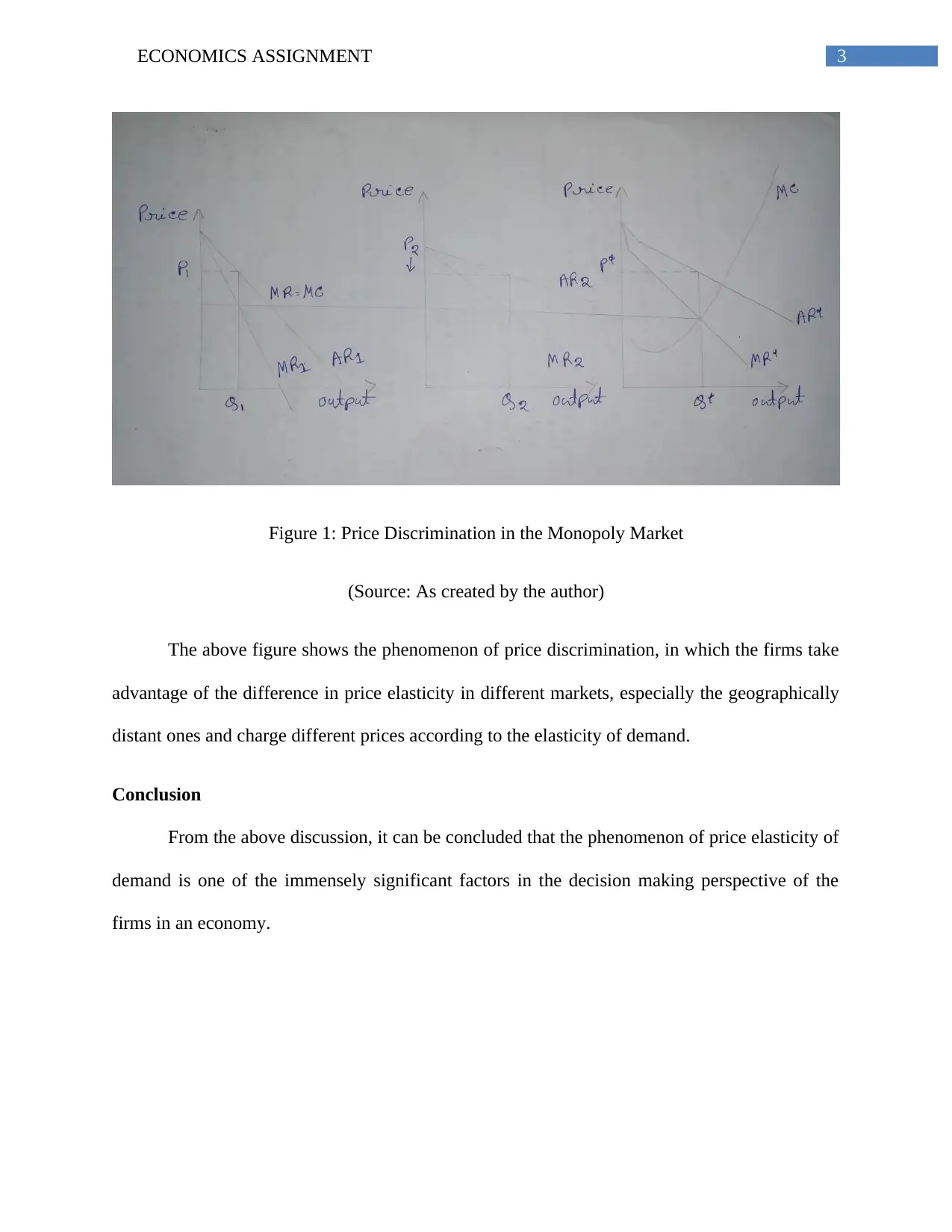
3ECONOMICS ASSIGNMENT
Figure 1: Price Discrimination in the Monopoly Market
(Source: As created by the author)
The above figure shows the phenomenon of price discrimination, in which the firms take
advantage of the difference in price elasticity in different markets, especially the geographically
distant ones and charge different prices according to the elasticity of demand.
Conclusion
From the above discussion, it can be concluded that the phenomenon of price elasticity of
demand is one of the immensely significant factors in the decision making perspective of the
firms in an economy.
Figure 1: Price Discrimination in the Monopoly Market
(Source: As created by the author)
The above figure shows the phenomenon of price discrimination, in which the firms take
advantage of the difference in price elasticity in different markets, especially the geographically
distant ones and charge different prices according to the elasticity of demand.
Conclusion
From the above discussion, it can be concluded that the phenomenon of price elasticity of
demand is one of the immensely significant factors in the decision making perspective of the
firms in an economy.
Paraphrase This Document
Need a fresh take? Get an instant paraphrase of this document with our AI Paraphraser
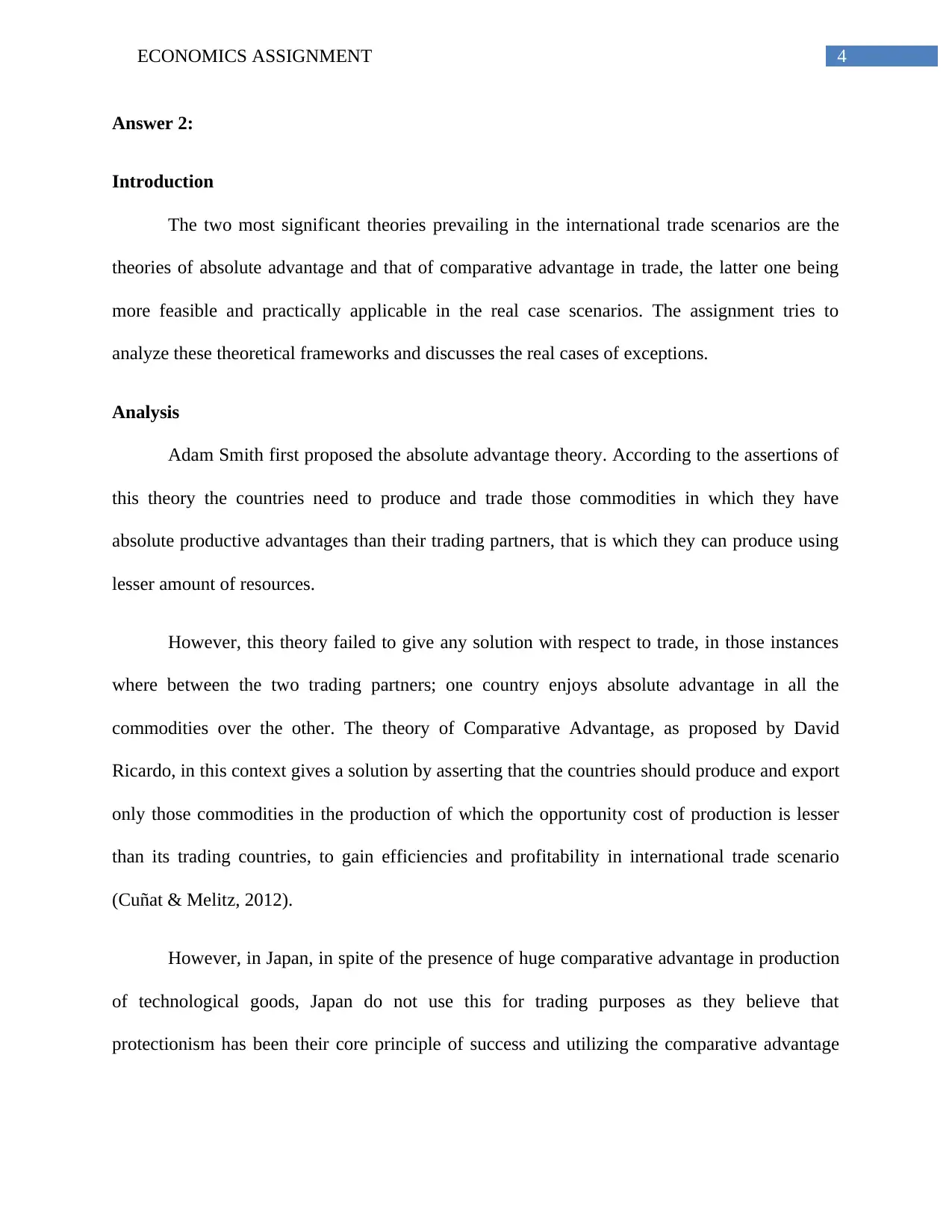
4ECONOMICS ASSIGNMENT
Answer 2:
Introduction
The two most significant theories prevailing in the international trade scenarios are the
theories of absolute advantage and that of comparative advantage in trade, the latter one being
more feasible and practically applicable in the real case scenarios. The assignment tries to
analyze these theoretical frameworks and discusses the real cases of exceptions.
Analysis
Adam Smith first proposed the absolute advantage theory. According to the assertions of
this theory the countries need to produce and trade those commodities in which they have
absolute productive advantages than their trading partners, that is which they can produce using
lesser amount of resources.
However, this theory failed to give any solution with respect to trade, in those instances
where between the two trading partners; one country enjoys absolute advantage in all the
commodities over the other. The theory of Comparative Advantage, as proposed by David
Ricardo, in this context gives a solution by asserting that the countries should produce and export
only those commodities in the production of which the opportunity cost of production is lesser
than its trading countries, to gain efficiencies and profitability in international trade scenario
(Cuñat & Melitz, 2012).
However, in Japan, in spite of the presence of huge comparative advantage in production
of technological goods, Japan do not use this for trading purposes as they believe that
protectionism has been their core principle of success and utilizing the comparative advantage
Answer 2:
Introduction
The two most significant theories prevailing in the international trade scenarios are the
theories of absolute advantage and that of comparative advantage in trade, the latter one being
more feasible and practically applicable in the real case scenarios. The assignment tries to
analyze these theoretical frameworks and discusses the real cases of exceptions.
Analysis
Adam Smith first proposed the absolute advantage theory. According to the assertions of
this theory the countries need to produce and trade those commodities in which they have
absolute productive advantages than their trading partners, that is which they can produce using
lesser amount of resources.
However, this theory failed to give any solution with respect to trade, in those instances
where between the two trading partners; one country enjoys absolute advantage in all the
commodities over the other. The theory of Comparative Advantage, as proposed by David
Ricardo, in this context gives a solution by asserting that the countries should produce and export
only those commodities in the production of which the opportunity cost of production is lesser
than its trading countries, to gain efficiencies and profitability in international trade scenario
(Cuñat & Melitz, 2012).
However, in Japan, in spite of the presence of huge comparative advantage in production
of technological goods, Japan do not use this for trading purposes as they believe that
protectionism has been their core principle of success and utilizing the comparative advantage
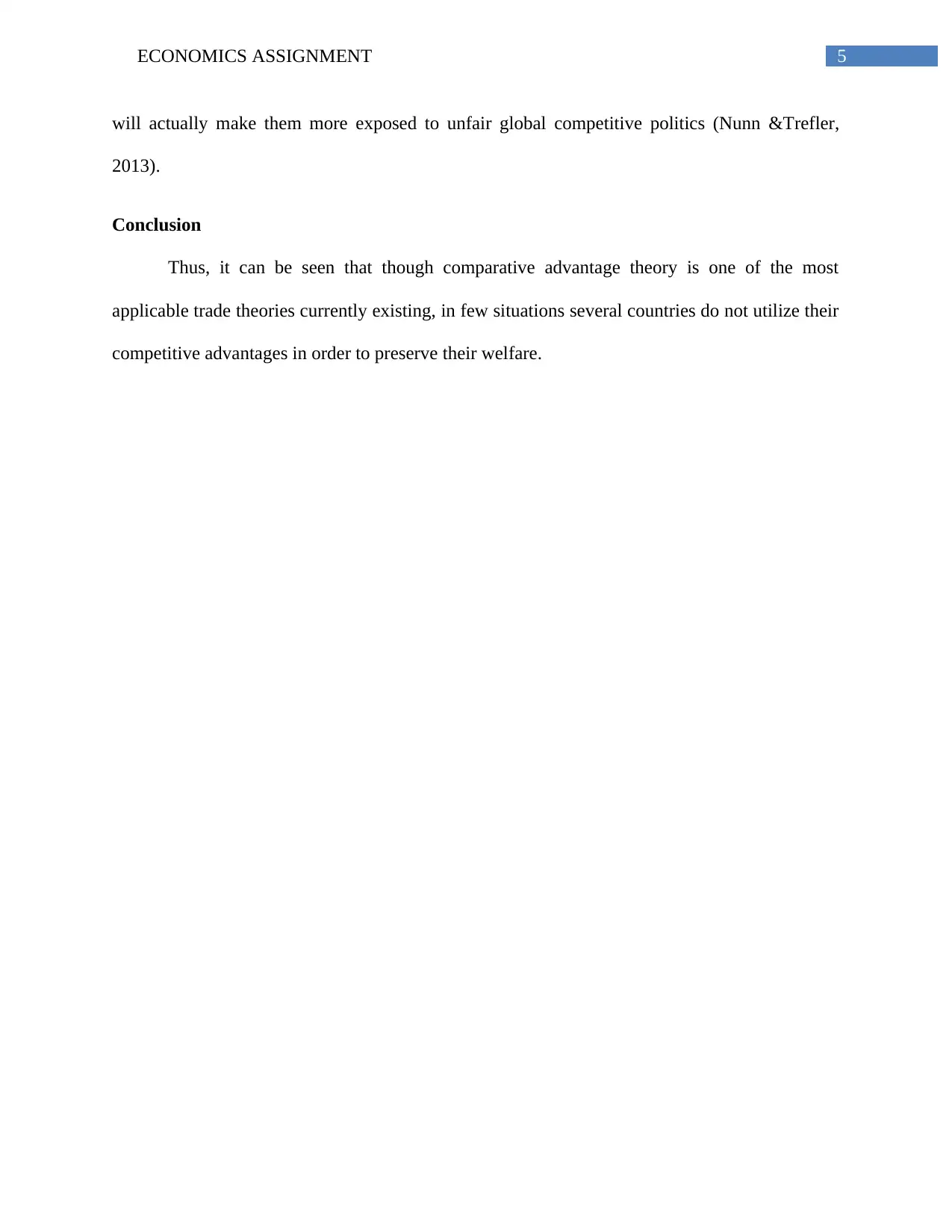
5ECONOMICS ASSIGNMENT
will actually make them more exposed to unfair global competitive politics (Nunn &Trefler,
2013).
Conclusion
Thus, it can be seen that though comparative advantage theory is one of the most
applicable trade theories currently existing, in few situations several countries do not utilize their
competitive advantages in order to preserve their welfare.
will actually make them more exposed to unfair global competitive politics (Nunn &Trefler,
2013).
Conclusion
Thus, it can be seen that though comparative advantage theory is one of the most
applicable trade theories currently existing, in few situations several countries do not utilize their
competitive advantages in order to preserve their welfare.
⊘ This is a preview!⊘
Do you want full access?
Subscribe today to unlock all pages.

Trusted by 1+ million students worldwide

6ECONOMICS ASSIGNMENT
References
Cuñat, A., & Melitz, M. J. (2012). Volatility, labor market flexibility, and the pattern of
comparative advantage. Journal of the European Economic Association, 10(2), 225-254.
Ekelund Jr, R. B., & Hébert, R. F. (2013). A history of economic theory and method. Waveland
Press
Nunn, N., &Trefler, D. (2013). Domestic institutions as a source of comparative advantage (No.
w18851). National Bureau of Economic Research.
Varian, H. R. (2014). Intermediate Microeconomics: A Modern Approach: Ninth International
Student Edition. WW Norton & Company
References
Cuñat, A., & Melitz, M. J. (2012). Volatility, labor market flexibility, and the pattern of
comparative advantage. Journal of the European Economic Association, 10(2), 225-254.
Ekelund Jr, R. B., & Hébert, R. F. (2013). A history of economic theory and method. Waveland
Press
Nunn, N., &Trefler, D. (2013). Domestic institutions as a source of comparative advantage (No.
w18851). National Bureau of Economic Research.
Varian, H. R. (2014). Intermediate Microeconomics: A Modern Approach: Ninth International
Student Edition. WW Norton & Company
1 out of 7
Related Documents
Your All-in-One AI-Powered Toolkit for Academic Success.
+13062052269
info@desklib.com
Available 24*7 on WhatsApp / Email
![[object Object]](/_next/static/media/star-bottom.7253800d.svg)
Unlock your academic potential
Copyright © 2020–2025 A2Z Services. All Rights Reserved. Developed and managed by ZUCOL.





